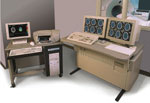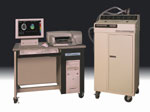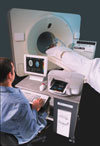|
|
|
XeCT System-2 allows physiological cerebral
blood flow (CBF) measurments with your existing CT.
|
| |
 Click on image to enlarge
Click on image to enlarge
|
Xenon CT System-2 is used in the quantitative determination of
CBF with equal accuracy in both cortical and deep brain tissue. Xenon CT
CBF provides direct anatomic correlation between flow and anatomy as seen on the
CT images. XeCT/CBF studies may be repeated at 15-20 minute intervals to
follow rapidly occurring events, evaluate the effect of physiologic challenges
(for example, to assess hemodynamic reserve) and to evaluate therapy. XeCT/CBF
provides physiological information not available from alternative CBF
modalities.
Data produced by XeCT/CBF System-2 correlate well with data obtained using
other CBF modalities in both animals and humans.
|
| |
|
Xenon CT System-2 Components:
|
| |
 Click on image to enlarge
Click on image to enlarge
|
Enhancer
3000 gas delivery system with patient monitor is
remotely controlled by the Xe/CT system computer and is mobile such that it can
be moved between CT scanners. The control panel on top of the Enhancer 3000
provides an alternative to remote control from the CT operator's room.
The Xe/CT System-2 also includes the operator's console with high-speed
personal computer, flat LCD monitor, trackball, high-resolution color printer
and optical disk archive system.
|
| |
|
When "Time is Brain" our technology delivers unsurpassed information to quantify your patientís condition quickly and expedite appropriate treatment.
|
| |
|
XeCT/CBF studies are
useful in the early diagnosis and management of acute, subacute, and chronic
stroke. The different etiologies of stroke require different management
strategies. A CT image may not be altered for hours or days following an
irreversible ischemic injury. A XeCT/CBF study may be performed immediately
following the head CT, which most stroke patients undergo upon presentation to the
hospital. XeCT/CBF studies can differentiate between infarction and
regions of low cerebral blood flow. This permits appropriate selection of
patients who will benefit from thrombolytic therapy, and identification of other
patients in whom therapy to increase flow or induce perfusion would likely
result in no clinical benefit while carrying a risk of producing a hemorrhage.
XeCT/CBF studies are beneficial in identifying flow below the threshold for
irreversible ischemia (15mL/100g/min). Irreversible brain injury may be
predicted with confidence if the absence of flow is observed 3 to 4 hours after
injury onset. Irreversible ischemic flow within the brain stem, which is vital
for supporting life function, may be defined soon after clinical deterioration,
and aid in the definition of brain death. In addition, patients with low CBF
(15mL/100g/min) may be candidates for acute aggressive interventions to augment
flow and prevent conversion of a reversible to an irreversible ischemic region
if identified prior to 3 to 4 hours post onset. In subacute disorders,
XeCT/CBF examination followed by a second study accompanied by a vasodilatory
challenge may provide insight as to whether regions around infarction are at
increased risk for converting to irreversibly injured tissue. In patients with
intracerebral hemorrhage, identification of ischemia in brain tissue around the
hemorrhage can help determine whether evacuation of the clot is indicated.
XeCT/CBF studies
are medically and neurologically safe.
|
| |
|
|
| |
|
Xenon CT/CBF, other clinical indications:
|
| |

Click on image to enlarge
|
XeCT/CBF studies have been used extensively to evaluate and
manage patients with occlusive vascular disease, head trauma, aneurysm and
arteriovenous malformation. This technique has also been used in a wide variety
of other conditions, including chronic ischemia, limb-shaking ischemia,
subarachnoid hemorrhage and vasospasm, brain death, carotid resection/sacrifice,
STA-MCA bypass, Moyamoya disease, epilepsy, glioma, cranial defects, vascular
and Alzheimerís dementia, hepatic failure, periventricular radiolucency,
hydrocephalus, chronic subdural hematomas, subclavian steal syndrome,
alcoholism, degenerative disease, migraine, multiple sclerosis and sleep
disorders.
|
|
| |
|
Summary of Safety:
|
| |
|
Xenon gas used in XeCT/CBF studies is not radioactive.
Xenon is a metabolically inert, monatomic, lipid-soluble and readily diffusible
tracer, that rapidly crosses the blood brain barrier and is preferentially
distributed within the highly lipid cells of the brain. Despite its lack of
chemical reactivity, xenon associates preferentially but transiently with red
blood cells, particularly the globin structure. There is no evidence that
exposure to 26% xenon for 4.5 minutes can cause significant adverse local
or systemic effects in humans. Sensory changes occur in some patients, and are
usually benign and transient. The most common effects are euphoria and
lightheadedness. The incidence of respiratory depression is extremely low and is
easily reversed by the monitoring staff reminding the patient to breathe.
|
| |
| Back |
| |
| |
|

